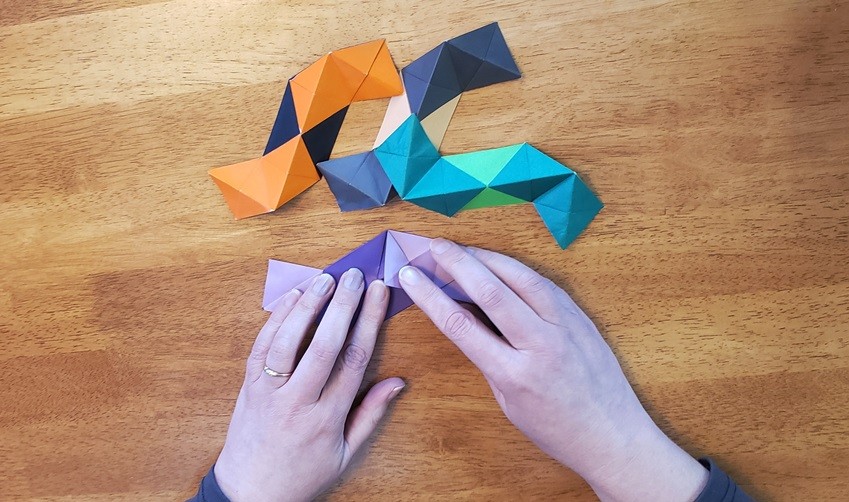When I lived in Japan, a skill I picked up was origami – the technique of folding paper to make things.
I do origami for fun. I also use this skill in the workplace – as a creative activity with individuals for social fun, and as an object-lesson activity with teams for creative learning.
It’s a very kinaesthetic activity. And I bet you’ve got some people on your team who like to fiddle with things using their hands. Origami is a great break away from knowledge work, where your hands were on a keyboard or holding pens. You get to do something that feels truly creative, and to produce something very concrete and tangible that can be admired – no electricity or internet required!
For social pleasure
A handmade object is a great gift. Even though the origami paper is very low cost, the experience of choosing a pretty piece of paper from a stack, then having it folded in front of you into an object you requested – is priceless!
These are the kinds of things I’ve made for others.

Difficulty Factor of 5
There is a particular style of origami, called kusadama (literally means medicine ball). It’s much more involved than folding a single piece of paper. It usually means multiple pieces of paper that come together to create a single object – that may be a ball or some other geometric shape. Some of the objects have pieces glued together, strung together, or interlocking together. They are fun to make as a group activity and look very impressive when finished.
Here’s some kusadama style objects:

Bow-tie Piece and Objects
One object has a simple ‘bow-tie’ piece that is created from 14 folds. It doesn’t look much here.

Make 12 of these pieces and interlock them to get a cube outline. Make 60 of the pieces, and interlock them to get a dodecahedron!

This object is particularly good for an object-lesson activity. Every person makes a piece, and then they come together to form a single object.
Here’s the instructions (PDF).
Changing minds at work
I had a group session I was facilitating: Everyone around the table was expecting a typically boring presentation on an organisational change that was coming.
Boy, were they surprised when I kicked it off by putting bits of origami paper on the table and telling them we were going to make something! At first there were reactions like “but I’m no good at crafts and things” and “this is kid stuff” and “these things are difficult”.
I showed them the bow-tie piece that they were going to make. I assured them we would walk through the instructions step-by-step. And when they were finished, I’d bring all the pieces together – unless of course, there was someone who felt particularly adventurous and wanted to do that for the team.
The human behaviour was fascinating. Two people grabbed the set of instructions and ploughed on ahead by themselves without waiting for my guidance. Others were slightly panicked and concerned at each step: “am I doing it right?”. As people had the paper in their hands and started folding, the anxiety dropped a little. As they watched others overcoming a struggle, they were encouraged that they could do so too. As they finished their piece, they felt such a sense of achievement in mere minutes, about something they thought they couldn’t do but in fact did. The energy in the group changed, and we had a very pleasant session with more openness and a dose of optimism in facing the change we were there to talk about.
Spreading the goodness
One of my colleagues (many years ago), loved doing the social origami at lunch breaks with me. And she went on to make lots of things for lots of people. I’d go to other people’s office and see some origami creation proudly displayed on their desk – and I’d know: Svetlana has been around! She told me that she established many great professional relationships with the simple giving of an origami object she made.
Svetlana told me recently that she’s continued to use the bow-tie piece technique in teams. And that after doing the origami activity it became a metaphor in daily team meetings of how each had pieces (of work) to do and contribute to the whole. They would talk about “what is your piece today?” and “how is your piece going?”. She said that the team created a stronger sense of working together as a result.
Maybe I can inspire you to put origami in the mix of your team activity?
Logistics in sourcing origami paper
Recommended source for getting origami paper in Australia.
The double-sided colour paper is particularly good for the bow-tie piece. 7.5cm square paper is best for adult hands, and interlocking the pieces for the first-time. The finished dodecahedron will be the size of a basketball.
Author
Helen Palmer is Founder and Principal Change Agent at Questo. While she’s good with her mind – she loves to roll up her sleeves and make things! Pretty coloured paper that can turn into something special and create a magical experience, ticks off two of the boxes in the work she loves to do with others.
Share with others



No responses yet